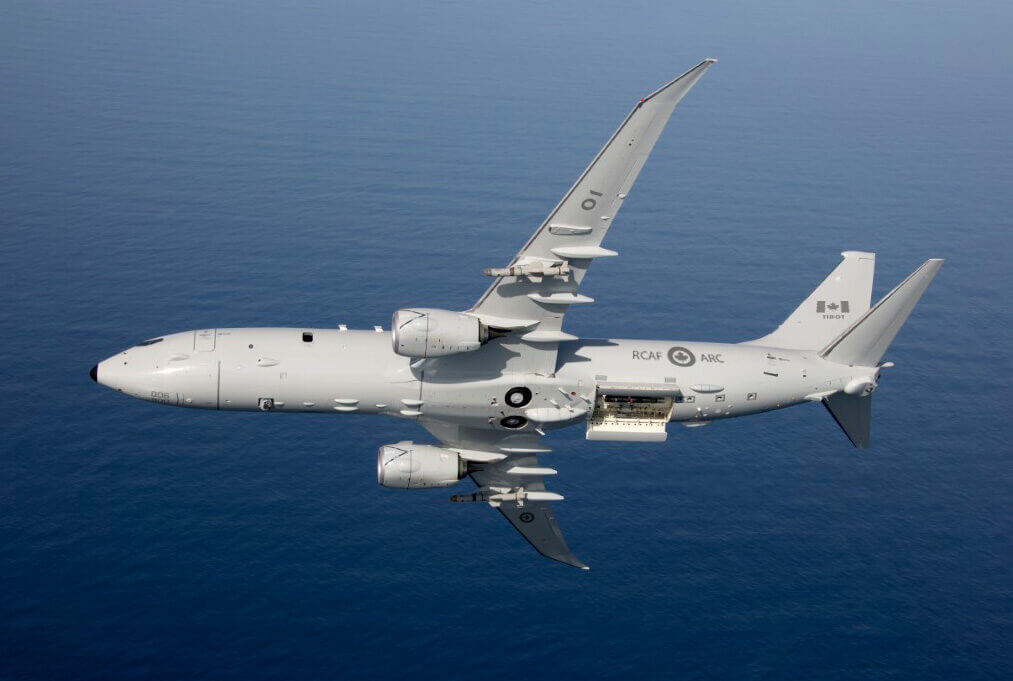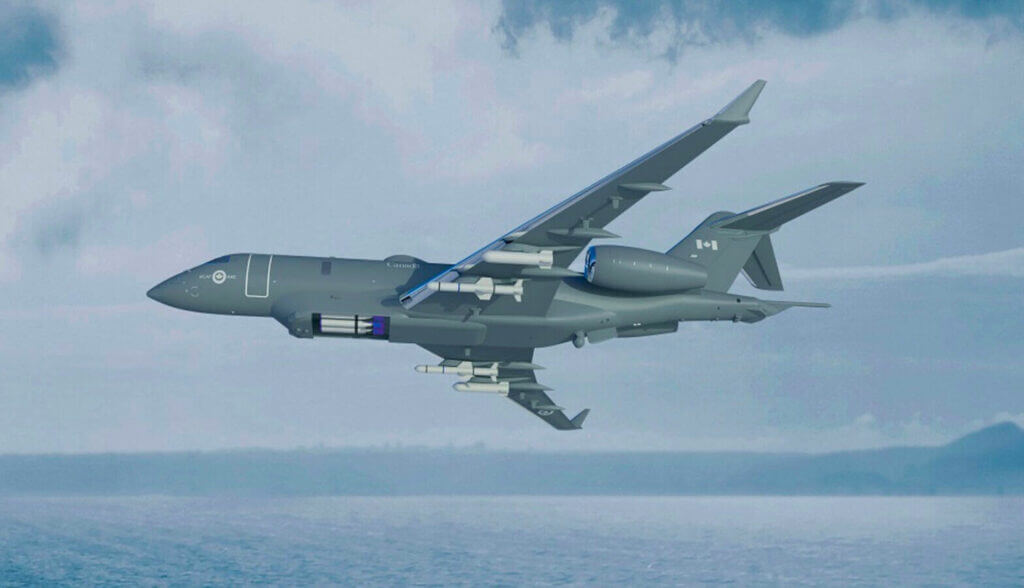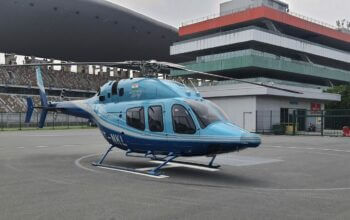Estimated reading time 16 minutes, 12 seconds.
For a project that even politicians have stated they want to de-politicize, the Canadian Multi-Mission Aircraft (CMMA) is rapidly becoming highly political.
In the space of 10 days in mid-November, the premiers of Ontario and Quebec, the Standing Committee on National Defence, and the United States ambassador to Canada all weighed in to try and influence a procurement process to replace the CP-140 Aurora maritime patrol aircraft.
Much of their concern stems from a March 2023 letter of request (LOR) issued by Public Services and Procurement Canada (PSPC) to the U.S. government for the acquisition cost of 16 Boeing P-8A Poseidon aircraft.
The LOR was delivered following a request for information (RFI) to the defence and aerospace industry in February 2022. Feedback from the RFI, together with a market analysis conducted by Avascent in 2021, suggested the P-8A was “the only currently available aircraft that meets all of the operational requirements” of the CMMA project, PSPC stated in March.
The Poseidon “is a proven capability that is operated by several of Canada’s defence partners,” the department noted, including Five Eyes allies like the United States, United Kingdom, Australia, and New Zealand, as well as Norway and South Korea. Germany, too, has ordered the P-8 and is expecting its first aircraft in October 2024.

“The issuance of a LOR does not commit Canada to purchasing the P-8A Poseidon and the project remains in options analysis,” PSPC emphasized in the statement. “The final decision will be based on the capability offered, availability, pricing, and benefits to Canadian industry.”
Despite those assurances that the government has not yet made a final decision, the LOR set off alarm bells at Bombardier, which together with General Dynamics Mission Systems-Canada, is proposing a Canadian-built multi-mission aircraft based on a Global 6500 airframe.
Fears of a sole-source contract were further heightened when, on June 27, the U.S. Defense Security Cooperation Agency (DSCA) notified Congress of State Department approval for the potential foreign military sale (FMS) to Canada of 16 P-8As, plus associated equipment, initial servicing, and access to intellectual property and technical data, for approximately US$5.9 billion (about C$8 billion).
Since then, Bombardier has waged a vocal campaign to ensure its CMMA solution is part of a competitive tender.
On Nov. 7, Ontario Premier Doug Ford and Quebec Premier François Legault released a joint statement calling on the federal government “for an open and fair procurement process that allows Canadian companies to compete. Should the federal government maintain its intention to grant a sole-source contract, we’re calling on the House of Commons to request that the Parliamentary Budget Officer review the costs and consequences related to this decision.”
Appearing before the Commons Committee on National Defence that same day to discuss the overall defence procurement process, Bombardier president and chief executive officer Eric Martel described the CMMA process as “deeply flawed and lacking transparency.”
He highlighted the company’s track record of modifying around 550 of its business jets for special mission configurations, including for the United States Air Force and Army, and accused the government of not consulting widely enough on capability being developed in Canada.
Bombardier responded to the high-level mandatory requirements contained in the February 2022 RFI “in good faith,” Martel told the committee members, and understood there would be no pre-selection or shortlisting of options at that time, or that the government wanted a military off-the-shelf solution. He also questioned the change in schedule, which originally required an initial operating capability (IOC) by 2040, rather than in the early 2030s.
Bombardier and its partners are demanding “an open, unbiased call for tender with objective and realistic selection criteria,” he said, insisting the companies could meet the new timeline with a clean sheet build that could require extensive certification.
“We have a more capable solution. Our airplane can fly faster, higher, further,” said Martel. “We have a lower cost. We believe we’re going to be $3 billion to $4 billion cheaper. . . . The cost of operating our airplane will be 30 to 40 per cent less, with 40 per cent fewer fuel emissions, which I believe should also be a criteria.”
He suggested to the committee that the P-8A, a militarized variant of the Boeing 737NG platform, is a dated aircraft that “has been in service for decades now. We are talking about offering a state-of-the-art solution that other countries are approaching us about,” though he did not name any potential customers.
Martel also claimed some P-8 customers were “thinking about not taking all the deliveries of the P-8 because they are dissatisfied and considering other options.”
Perhaps contradicting that, Germany, which originally placed an order for five Poseidon aircraft, on Nov. 17 increased its buy to eight.
In presentations to the 2023 Canadian Aerospace Summit earlier that day, both Martel and Joel Houde, vice-president and general manager of General Dynamics Mission Systems-International, noted the importance of Canadian sovereignty of intellectual property and investment in local innovation.
“When there is a capability in Canada, we need to buy Canadian,” said Houde, or risk losing talent to other sectors or countries. “All we are asking for is a chance to compete, to demonstrate that we have that ability, and we can be cost-effective. I think Canada needs to invest in those areas where you can be the best in the world.”
Course Change
In an appearance before the House of Commons Standing Committee on Government Operations and Estimates on Oct. 17, senior government officials laid out some of the reasoning for the LOR for the P-8 purchase price and the change in the CMMA project schedule.
Simon Page, Assistant Deputy Minister, Defence and Marine Procurement at PSPC, said that the market assessment by Avascent suggested to the project team that “it would be very challenging for Canadian industry to develop a CMMA solution with the required capabilities within the timeframe needed to meet the estimated life expectancy of the CP-140 Aurora aircraft.”
The RFI was issued in February 2022 to “validate the findings of this report” and “to assess the industry’s interest, capability, and experience to provide a solution meeting these requirements,” he said.
“Out of the 23 responses received from that consultation, only Boeing provided a non-developmental military-off-the-shelf aircraft. . . . The other responses were either only partial or sub-system-level solutions, or based on an aircraft not yet developed or requiring extensive modification.”
Page added that consultations with Five Eyes partners “confirmed that no other allied country currently has plans to develop a multi-mission platform, except for France that has requested Airbus and Dassault to produce studies for a future maritime patrol aircraft.”
“It is important to note that the issuance of [the LOR] did not commit Canada to purchase the aircraft. It merely allowed Canada to understand the capability, cost, availability, and benefits to Canadian industry in more detail.”
Asked about schedule change and the difference in capabilities between the CP-140 Aurora and a future CMMA, Bill Matthews, Deputy Minister of National Defence, noted that “the CP-140 is an old plane. It was put into service in 1980. It’s been upgraded several times since it first came into service, but from a capability perspective, it is losing relevance rather quickly — first because it’s old and then because our adversaries are getting more complicated much more quickly than we had hoped. There is only so much you can do to upgrade a plane that old to keep it relevant. Our current plan is 2030.”
The CMMA will offer improved self-defence, he added. “You want to put an asset into theatre that is not only capable of self-defence but that also has more modern offensive capability in terms of the missiles it can carry, both for anti-submarine and anti-surface warfare.”
To continue to be interoperable and relevant in contested theatres of operations, “the ability to exchange information with our NATO partners and with other allies is absolutely critical,” Matthews told the committee. “When you look at the current asset, you see that it’s dated and it’s becoming increasingly difficult to sustain it. If we look at what our allies have done, we see that all our Five Eyes partners and many of our NATO allies have gone to the P-8, so interoperability is absolutely critical. That’s not to say that the P-8 is the only thing that can do it, but lots of our allies have already gone there.”
Counterpoint
While Bombardier’s Summit and Commons Committee presentations grabbed media and political attention, Boeing’s counterpoint was no less convincing. In an address to the Aerospace Summit on Nov. 8, Vincent Logsdon, vice-president of global business development and strategic marketing for Boeing Defense, Space & Security, said the “P-8 is a real platform that is already delivering world-class military capabilities and enviable economic benefits for the many allies around the globe that have selected it as their multi-mission aircraft solution.”
And where Bombardier pitched sovereignty in a Global 6500-based platform, Boeing highlighted interchangeability with partners, especially the Five Eyes allies. Logsdon noted the value of allied logistics chains to sustain combat effectiveness, and the strength of a platform that shares 86 per cent commonality with the commercial 737NG aircraft.

“If Canada chooses P-8 for its CMMA solution, it will capitalize on the opportunity to leverage the global 737 and P-8 infrastructure, along with the logistics chains of its closest allies,” he said. “Collectively, those allies have accumulated more than 500,000 flight hours with their P-8 fleets since the first P-8 entered service with the U.S. Navy in 2012 – only 11 years ago.”
Contrary to the assertion that the Poseidon is an aging aircraft, Logsdon noted that the “P-8s were designed – and successfully tested – to meet a specification for 25 years/25,000 flight hours of service life. Given the trend toward service life extensions for major capital defence equipment, P-8s are likely to be operating well into the 2060s.”
Speaking on background, a Boeing official added that the U.S. Navy, the largest P-8 customer, only achieved IOC in 2013, and the average age of their fleet is 6.2 years. Moreover, Boeing is on contract to deliver 11 more P-8s to the U.S. Navy.
Logsdon countered the claim of customer dissatisfaction, stating that “many of our allies have sundowned their P-3 fleets in order to acquire P-8s instead.”
It is unclear how Bombardier could deliver 16 aircraft and initial spares, tooling, and servicing for $3 billion to $4 billion less than the U.S. government FMS estimate of $8 billion.
Boeing and the U.S. Navy invested nine years and over US$7 billion in research and development to get the first P-8s to initial operating capability, Logsdon observed. That investment means “virtually no technical, financial, or schedule risk” to Canada, said.
The final salvo in the CMMA project has yet to be fired. But based on the testimony of Martel and senior government officials, the National Defence committee on Nov. 9 voted to approve a motion calling on the government to “proceed by way of a formal request for proposals before awarding any procurement contract of the new Canadian Multi-Mission Aircraft.”
It was not lost on several committee members that the step they were taking was a form of political interference — the same type of interference that a number of witnesses had lamented in testimony over the previous months during committee hearings on the impact of Canada’s procurement process on the Canadian Armed Forces. It even reportedly prompted a letter from U.S. ambassador to Canada, David Cohen, to Cabinet Ministers urging them to proceed with the P-8 acquisition.









Of course BBDs crayon drawing can climb higher, fly faster, for longer, burning less fuel and costing 30% tp 40% less. WHY hasnt anyone else discovered this super paper airplane and arent rushing to Montreal to buy squadrons of them? Methinks BBD is missing their regular funding at the government trough and are desperately trying to get back into anything that will help them get there.
As I’ve said many times here and elsewhere, we only need a few P8s and the rest of the CMMA fleet should be Bizjets. Over-diversification of RCAF fleet can be avoided by replacing the Challenger VIP jet fleet with the same Bizjet model. For many if not most of the “multi-mission aircraft” missions, the P-8 is massively overpriced overkill that will only bleed badly needed funds from the rest of the Canadian Armed Forces, especially on domestic missions. You don’t need a B737 and 10 person crew to photograph Red River floods in Manitoba or off-season fishing off the Grand Banks. Sure the ability to fire a dozen or so stand-off cruise missiles into mainland China from a safe distance might make some people’s undies feel tight in the front but that’s a deterrent capability that would likely never be used in real life. So why do we need all 16 CMMA these aircraft? Meanwhile as Skies has often reported, the current CP-140s consistently outperform the P8 in the American-hosted “Dragon Belt” ASW competitions, using a General Dynamics ASW suite similar or identical to what is proposed for the Bombardier alternative. In fact it seems that a P8 has not won a “Dragon Belt” since 2020 when all competitors (with the exception of South Korean P3 Orion) were operating P8s and an American P8 has never won the competition despite being in service for over a decade and USA being the annual competition’s host. Furthermore “interchangeability” with allies also means redundancy. Do we really need so many P8s when our allies can also bring so many of their own to the next mission? A Bizjet that can fly faster higher longer (and I assume possibly can scramble or launch on short notice faster too) in addition to a P8 would be a more well-rounded solution. The 6500 platform is only “unproven” insofar as an internal weapons bay but that can be the differentiator between the 2 types: the 6500 with external weapons only does the smaller/low threat/lightly armed or unarmed jobs and P8 can be reserved for the bigger jobs like saturating mainland China with cruise missiles
Here’s the issue with your opinion.
we only need a few P8s – This tells me you have no idea what the CP-140 fleet is up to, they are all over the place, just because you don’t hear about it, doesn’t mean they are sitting idle.
In fact it seems that a P8 has not won a “Dragon Belt” since 2020 – A competition dumbed down to make the playing field fair. If the P8 wasn’t the best out there, then why are so many nations going with it? Even Korea chose the P8 over the SAAB Swordfish (Bombardier/GD aircraft), and they have a smaller area to patrol…
Do we really need so many P8s when our allies can also bring so many of their own to the next mission? – I know right? Why even have a military at all, when the allies can do all the heavy lifting. In order to have economic security, you need physical security. There will come a time when we will need to defend our interests, no one else will do that for us.
Now, go ahead and read up on this, you’ll find that back in 2022 the government reached out to industry, and out of the 22 responses, only 1 meet all the requirements…. Guess who that was??? Boeing.
This is why our military is in shambles, arm chair generals such as yourself feel like your opinion matters, when it doesn’t
Bombardier is sitting there with their hands out again. They have nothing, not even on paper. If they were serious about this they should had something on paper years ago. They knew this was coming, it’s just they want the government to pay for the handouts and prototypes. They could have tried selling to our allies long ago, where were they? How many years is this going take to develop a one of kind that only Canada will use?
Liberals make Canada worse again by killing our economy and industry